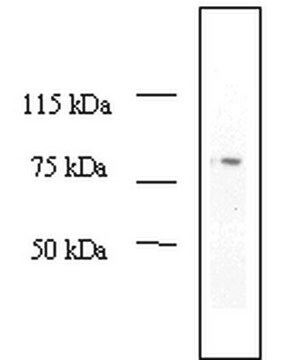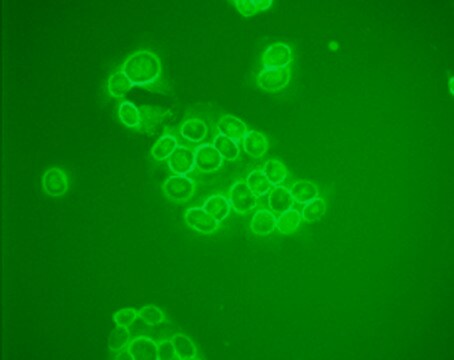추천 제품
생물학적 소스
mouse
결합
unconjugated
항체 형태
purified from hybridoma cell culture
항체 생산 유형
primary antibodies
클론
HDM2-323, monoclonal
양식
buffered aqueous solution
분자량
antigen ~90 kDa
종 반응성
human, mouse
농도
~2 mg/mL
기술
indirect ELISA: suitable
microarray: suitable
western blot: 1-2 μg/mL (whole cell extract of 293T cells transfected with human MDM2)
동형
IgG2a
UniProt 수납 번호
배송 상태
dry ice
저장 온도
−20°C
타겟 번역 후 변형
unmodified
유전자 정보
human ... MDM2(4193)
mouse ... Mdm2(17246)
일반 설명
Monoclonal Anti-MDM2 (mouse IgG2a isotype) is derived from the HDM2-323 hybridoma produced by the fusion of mouse myeloma cells and splenocytes from BALB/c mice. MDM2 (the human homologue of Mdm2, a 90 kDa molecule), is a transcriptional target of p53.
면역원
synthetic peptide corresponding to amino acids 389-402 of human MDM2 conjugated to KLH.
애플리케이션
Anti-MDM2 antibody, Mouse monoclonal has been used in western blotting and enzyme linked immunosorbent assay (ELISA).
생화학적/생리학적 작용
MDM2 functions in the activation of p53 resulting in MDM2 expression, which consequently inhibits p53 transcriptional function. MDM2 accomplishes this inhibition in two ways: because of its physical interaction with p53, MDM2 both represses p53 transcriptional activity and mediates the degradation of p53. Overexpression of MDM2 results in reduced quantities of coexpressed p53, and disruption of the p53-MDM2 interaction by mutation results in both activation and accumulation of p53. MDM2 protein has been shown to activate cell proliferation by stimulating the S-phase-inducing transcription factors, E2F1/DP1.5 The amplification of the MDM2 gene has been demonstrated in various human neoplasms.
물리적 형태
Solution in 0.01 M phosphate buffered saline, pH 7.4, containing 15 mM sodium azide.
면책조항
Unless otherwise stated in our catalog or other company documentation accompanying the product(s), our products are intended for research use only and are not to be used for any other purpose, which includes but is not limited to, unauthorized commercial uses, in vitro diagnostic uses, ex vivo or in vivo therapeutic uses or any type of consumption or application to humans or animals.
적합한 제품을 찾을 수 없으신가요?
당사의 제품 선택기 도구.을(를) 시도해 보세요.
Storage Class Code
10 - Combustible liquids
WGK
WGK 3
Flash Point (°F)
Not applicable
Flash Point (°C)
Not applicable
가장 최신 버전 중 하나를 선택하세요:
Mdm2 is a RING finger-dependent ubiquitin protein ligase for itself and p53
Fang S, et al.
The Journal of Biological Chemistry, 275(12), 8945-8951 (2000)
Dan Zhu et al.
The Journal of clinical investigation, 125(4), 1497-1508 (2015-03-10)
Synaptic plasticity is the ability of synapses to modulate the strength of neuronal connections; however, the molecular factors that regulate this feature are incompletely understood. Here, we demonstrated that mice lacking brain-specific angiogenesis inhibitor 1 (BAI1) have severe deficits in
Zehavit Goldberg et al.
The EMBO journal, 21(14), 3715-3727 (2002-07-12)
The p53 tumor suppressor is inhibited and destabilized by Mdm2. However, under stress conditions, this downregulation is relieved, allowing the accumulation of biologically active p53. Recently we showed that c-Abl is important for p53 activation under stress conditions. In response
Xiaobin Wu et al.
OncoTargets and therapy, 11, 3111-3117 (2018-06-07)
The role of dysfunction of MCPH1, a recently identified tumor suppressor gene, has not yet been established in lung cancer. In our previous study, it was reported that MCPH1 expression is downregulated in lung cancer tissues and that MCPH1 overexpression
Shuichi Fujioka et al.
The Journal of biological chemistry, 279(26), 27549-27559 (2004-04-23)
Both pro- and antiapoptotic activities of NF-kappaB transcription factor have been observed; however, less is known about the mechanism by which NF-kappaB induces apoptosis. To elucidate how NF-kappaB regulates proapoptotic signaling, we performed functional analyses using wild-type, ikk1(-/-), ikk2(-/-), rela(-/-)
자사의 과학자팀은 생명 과학, 재료 과학, 화학 합성, 크로마토그래피, 분석 및 기타 많은 영역을 포함한 모든 과학 분야에 경험이 있습니다..
고객지원팀으로 연락바랍니다.







